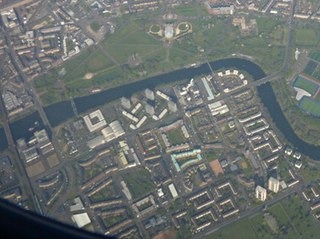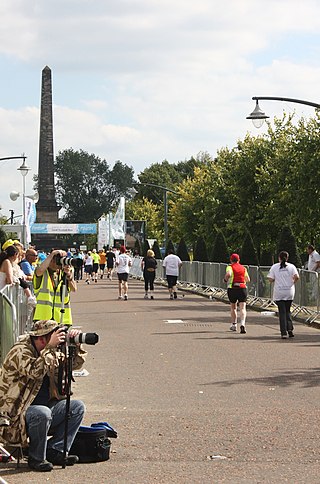
The River Clyde is a river that flows into the Firth of Clyde in Scotland. It is the ninth-longest river in the United Kingdom, and the second-longest in Scotland. It runs through the major city of Glasgow. Historically, it was important to the British Empire because of its role in shipbuilding and trade. To the Romans, it was Clota, and in the early medieval Cumbric language, it was known as Clud or Clut. It was central to the Kingdom of Strathclyde.
The Gorbals is an area in the city of Glasgow, Scotland, and former burgh, on the south bank of the River Clyde. By the late 19th century, it had become densely populated; rural migrants and immigrants were attracted by the new industries and employment opportunities of Glasgow. At its peak, during the 1930s, the wider Gorbals district had swollen in population to an estimated 90,000 residents, giving the area a very high population density of around 100,000 per sq. mi. (40,000/km2). Redevelopment after WWII has taken many turns, and the area's population is substantially smaller today. The Gorbals was also home to 16 high rise flat blocks; only six are standing as of 2024, and two of them are set to come down in the next couple of years.

Kelvingrove Park is a public park located on the River Kelvin in the West End of the city of Glasgow, Scotland, containing the Kelvingrove Art Gallery and Museum.

The Molendinar Burn is a burn in Glasgow, Scotland. It was the site of the settlement, Mellingdenor, that grew to become the kernel of Glasgow, and where St Mungo founded his church in the 6th century. It was later used to power the growing town's mills and the name became adapted because the word "molendinar" means "relating to a mill or millers", possibly because that is what the Welsh name Mellingdenor originally meant.
Glasgow Gorbals was a parliamentary constituency in the city of Glasgow. From 1918 until 1974, it returned one Member of Parliament (MP) to the House of Commons of the Parliament of the United Kingdom, elected by the first-past-the-post system.
The city of Glasgow, Scotland, has many amenities for a wide range of cultural activities, from curling to opera and from football to art appreciation; it also has a large selection of museums that include those devoted to transport, religion, and modern art. In 2009 Glasgow was awarded the title UNESCO Creative City of Music in recognition of its vibrant live music scene and its distinguished heritage. Glasgow has three major universities, each involved in creative and literary arts, and the city has the largest public reference library in Europe in the form of the Mitchell Library. Scotland's largest newspapers and national television and radio companies are based in the city.

Hutchesontown is an inner-city area in Glasgow, Scotland. Mostly residential, it is situated directly south of the River Clyde and forms part of the wider historic Gorbals district, which is covered by the Southside Central ward under Glasgow City Council.

The A728 is a route number in Glasgow, Scotland applied to two connected roads.
Glasgow was a burgh constituency of the House of Commons of the Parliament of the United Kingdom from 1832 to 1885. It returned two Member of Parliament (MPs) until 1868, and then three from 1868 to 1885. Elections were held using the bloc vote system.

The Glasgow Necropolis is a Victorian cemetery in Glasgow, Scotland. It is on a low but very prominent hill to the east of Glasgow Cathedral. Fifty thousand individuals have been buried here. Typical for the period, only a small percentage are named on monuments and not every grave has a stone. Approximately 3,500 monuments exist here.

Bridge Street railway station, now disused, was the original Glasgow terminus of the Glasgow and Paisley Joint Railway; jointly owned by the Glasgow, Paisley and Greenock Railway (GP&G), which later merged with the Caledonian Railway, and the Glasgow, Paisley, Kilmarnock and Ayr Railway (GPK&A), which became part of the Glasgow & South Western Railway.

Cathedral Square is a public square in the city of Glasgow, Scotland. Cathedral Square and precinct is situated adjacent to Glasgow Cathedral on High Street/Castle Street at John Knox Street. Nearby are many famous Glasgow landmarks such as Provand's Lordship, Glasgow Royal Infirmary, the Necropolis, the ceremonial Barony Hall of Strathclyde University, and the Glasgow Evangelical Church at the Square. It is one of six public squares and precincts in the city centre.
Eastern Football Club was a 19th-century football club based in Glasgow, Scotland. It was one of the founder members of the Scottish Football Association (SFA) and one of the sixteen teams to participate in the inaugural season of the Scottish Cup.

The city of Glasgow, located in Scotland, UK, is represented in both the Westminster Parliament in London, and the Scottish Parliament in Holyrood, Edinburgh. At Westminster, it is represented by seven Members of Parliament (MPs), all elected to represent individual constituencies at least once every five years, using the first-past-the-post system of voting. In Holyrood, Glasgow is represented by sixteen MSPs, nine of whom are elected to represent individual constituencies once every five years using first-past-the-post, and seven of whom are elected as additional members, through proportional representation.

The Saltmarket is a thoroughfare in the City of Glasgow, Scotland. It is a southward continuation of the High Street, running south from Glasgow Cross to the junction with Clyde Street and Crown Street by the River Clyde. It runs past the High Court of Glasgow and also Glasgow Green. Along with the High Street and Crown Street it forms part of the A8.

The Great Scottish Run is a series of mass-participation road running events, held annually in the streets of Glasgow, Scotland in October. The event began as a full marathon in 1979, but later changed to a weekend of shorter events. The weekend now includes short events for children, a 10K roadrace, and a half marathon. The 2013 event, which was sponsored by the Bank of Scotland, featured over 30,000 competitors. It is the largest mass-participation sporting event in Scotland.

The Polmadie Bridge is a footbridge that crosses the River Clyde, Glasgow, Scotland between Glasgow Green to its north, and Oatlands to its south.

The Scottish Boat Race, also known as the Edinburgh vs. Glasgow Boat Race, is an annual rowing race between the University of Glasgow and the University of Edinburgh, in competing eights currently held on the River Clyde in Glasgow, Scotland. Started in 1877 on the Clyde above the tidal weir, the Scottish Boat Race has continued regularly since its inception with the exception of 1903 to 1919 due to GURC being a non-competitive club. The Race was originally contested in coxed fours but this was changed to eights after 1961. It is also believed to be the third oldest university boat race in the world, predated only by the Oxford and Cambridge Boat Race and the Yale-Harvard Regatta. Edinburgh University won the 2016 Scottish Boat Race after winning the Men's Scottish Boat Race, both Beginner crew races, the Women's Reserve race and the Ergometer Challenge.

King's Bridge is a road bridge spanning the River Clyde in Glasgow, Scotland. The bridge links Hutchesontown to the west and Glasgow Green to the east near the city centre.




![The Doulton Fountain [de] DoultonFountain-2017 (cropped).jpg](http://upload.wikimedia.org/wikipedia/commons/thumb/b/b9/DoultonFountain-2017_%28cropped%29.jpg/220px-DoultonFountain-2017_%28cropped%29.jpg)























